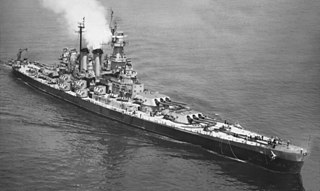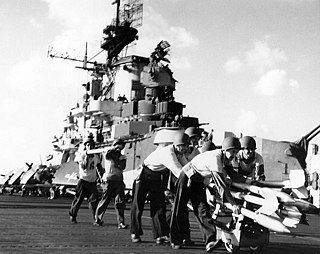Related Research Articles

USS Alabama (BB-60) is a retired battleship. She was the fourth and final member of the South Dakota class of fast battleships built for the United States Navy in the 1930s. The first American battleships designed after the Washington treaty system began to break down in the mid-1930s, they took advantage of an escalator clause that allowed increasing the main battery to 16-inch (406 mm) guns, but Congressional refusal to authorize larger battleships kept their displacement close to the Washington limit of 35,000 long tons (36,000 t). A requirement to be armored against the same caliber of guns as they carried, combined with the displacement restriction, resulted in cramped ships. Overcrowding was exacerbated by wartime modifications that considerably strengthened their anti-aircraft batteries and significantly increased their crews.

USS North Carolina (BB-55) is the lead ship of the North Carolina class of fast battleships, the first vessel of the type built for the United States Navy. Built under the Washington Treaty system, North Carolina's design was limited in displacement and armament, though the United States used a clause in the Second London Naval Treaty to increase the main battery from the original armament of twelve 14-inch (356 mm) guns to nine 16 in (406 mm) guns. The ship was laid down in 1937 and completed in April 1941, while the United States was still neutral during World War II.

USS Massachusetts (BB-59) is the third of four South Dakota-class fast battleships built for the United States Navy in the late 1930s. The first American battleships designed after the Washington treaty system began to break down in the mid-1930s, they took advantage of an escalator clause that allowed increasing the main battery to 16-inch (406 mm) guns, but refusal to authorize larger battleships kept their displacement close to the Washington limit of 35,000 long tons (36,000 t). A requirement to be armored against the same caliber of guns as they carried, combined with the displacement restriction, resulted in cramped ships, a problem that was exacerbated by wartime modifications that considerably strengthened their anti-aircraft batteries and significantly increased their crews.

USS South Dakota (BB-57) was the lead vessel of the four South Dakota-class fast battleships built for the United States Navy in the 1930s. The first American battleships designed after the Washington treaty system began to break down in the mid-1930s, the South Dakotas were able to take advantage of a treaty clause that allowed them to increase the main battery to 16-inch (406 mm) guns. However, congressional refusal to authorize larger battleships kept their displacement close to the Washington limit of 35,000 long tons (36,000 t). A requirement to be armored against the same caliber of guns as they carried, combined with the displacement restriction, resulted in cramped ships. Overcrowding was exacerbated by wartime modifications that considerably strengthened their anti-aircraft batteries and significantly increased their crews.

USS Washington (BB-56) was the second and final member of the North Carolina class of fast battleships, the first vessel of the type built for the United States Navy. Built under the Washington Treaty system, North Carolina's design was limited in displacement and armament, though the United States used a clause in the Second London Naval Treaty to increase the main battery from the original armament of nine 14 in (356 mm) guns to nine 16 in (406 mm) guns. The ship was laid down in 1938 and completed in May 1941, while the United States was still neutral during World War II. Her initial career was spent training along the East Coast of the United States until after Japan attacked Pearl Harbor on 7 December 1941, bringing the United States into the war.

USS Hornet (CV/CVA/CVS-12) is an Essex-class aircraft carrier built for the United States Navy (USN) during World War II. Completed in late 1943, the ship was assigned to the Fast Carrier Task Force in the Pacific Ocean, the navy's primary offensive force during the Pacific War. In early 1944, she participated in attacks on Japanese installations in New Guinea, Palau and Truk among others. Hornet then took part in the Mariana and Palau Islands campaign and most of the subsidiary operations, most notably the Battle of the Philippine Sea in June that was nicknamed the "Great Marianas Turkey Shoot" for the disproportionate losses inflicted upon the Japanese. The ship then participated in the Philippines Campaign in late 1944, and the Volcano and Ryukyu Islands campaign in the first half of 1945. She was badly damaged by a typhoon in June and had to return to the United States for repairs.

USS Essex (CV/CVA/CVS-9) was an aircraft carrier and the lead ship of the 24-ship Essex class built for the United States Navy during World War II. She was the fourth US Navy ship to bear the name. Commissioned in December 1942, Essex participated in several campaigns in the Pacific Theater of Operations, earning the Presidential Unit Citation and 13 battle stars. Decommissioned shortly after the end of the war, she was modernized and recommissioned in the early 1950s as an attack carrier (CVA), eventually becoming an antisubmarine aircraft carrier (CVS). In her second career, she served mainly in the Atlantic, playing a role in the Cuban Missile Crisis. She also participated in the Korean War, earning four battle stars and the Navy Unit Commendation. She was the primary recovery carrier for the Apollo 7 space mission.

USS Yorktown (CV/CVA/CVS-10) is one of 24 Essex-class aircraft carriers built during World War II for the United States Navy. Initially to have been named Bonhomme Richard, she was renamed Yorktown while still under construction, after the Yorktown-class aircraft carrier USS Yorktown (CV-5), which was sunk at the Battle of Midway. She is the fourth U.S. Navy ship to bear the name, though the previous ships were named for 1781 Battle of Yorktown. Yorktown was commissioned in April 1943, and participated in several campaigns in the Pacific Theater of Operations, earning 11 battle stars and the Presidential Unit Citation.

The Sixth Fleet is a numbered fleet of the United States Navy operating as part of United States Naval Forces Europe. The Sixth Fleet is headquartered at Naval Support Activity Naples, Italy. The officially stated mission of the Sixth Fleet in 2011 is that it "conducts the full range of Maritime Operations and Theater Security Cooperation missions, in concert with coalition, joint, interagency, and other parties, in order to advance security and stability in Europe and Africa." The current commander of the Sixth Fleet is Vice Admiral Eugene H. Black III.

USS Anzio (ACV/CVE/CVHE-57), was a Casablanca-class escort carrier of the United States Navy that saw service during World War II in the Pacific War. Originally classified as an auxiliary aircraft carrier ACV-57, the vessel was laid down in 1942, in Vancouver, Washington, by the Kaiser Shipbuilding Company and initially named Alikula Bay, then renamed Coral Sea and redesignated CVE-57 in 1943. Coral Sea took part in naval operations supporting attacks on the Gilbert and Marshall Islands, New Guinea and the Marianas Islands. In September 1944, she was renamed Anzio. As Anzio, the escort carrier took part in assaults on the Bonin Islands and Okinawa. Following the cessation of hostilities in 1945, Anzio was among the escort carriers used in Operation Magic Carpet, returning US soldiers to the United States. Following this service, she was laid up in reserve at Norfolk, Virginia, in 1946. The escort carrier was redesignated CVHE-57 on 15 June 1955, before being sold for scrap in 1959.

The Handley Page HP.67 Hastings is a retired British troop-carrier and freight transport aircraft designed and manufactured by aviation company Handley Page for the Royal Air Force (RAF). Upon its introduction to service during September 1948, the Hastings was the largest transport plane ever designed for the service.

The Consolidated Vultee XP-81 is a development of the Consolidated Vultee Aircraft Corporation to build a single seat, long range escort fighter that combined use of both turbojet and turboprop engines. Although promising, the lack of suitable engines combined with the end of World War II doomed the project.
Avianca Guatemala is an airline headquartered in Guatemala City. Aviateca was under government ownership and remained so until 1989 when it joined the TACA-organised Airline Alliance of Central America and was privatized. It was fully integrated into TACA, which later merged with Avianca.

USS Stephen Potter (DD-538), a Fletcher-class destroyer, was a ship of the United States Navy. Stephen Potter was commissioned in 1943 and served in the Pacific during World War II. She was then mothballed until 1951 whereupon she saw service in several areas including the Korean War. In 1958 she was placed in reserve, and scrapped in 1973.

USS Thatcher (DD-514), a Fletcher-class destroyer, was the second ship of the United States Navy to be named for Rear Admiral Henry K. Thatcher (1806–1880).

The General Electric J47 turbojet was developed by General Electric from its earlier J35. It first flew in May 1948. The J47 was the first axial-flow turbojet approved for commercial use in the United States. It was used in many types of aircraft, and more than 30,000 were manufactured before production ceased in 1956. It saw continued service in the US military until 1978. Packard built 3,025 of the engines under license.

The TG-10 is the military designation for the Blanik, Super Blaník and Blanik L-33 Solo Czechoslovakian sailplanes used for basic flight training at the United States Air Force Academy. The Academy maintained an inventory of 21 TG-10s, in these three variants, until 2012. The aircraft were flown by cadets and officers of the 94th Flying Training Squadron, 306th Flying Training Group, Nineteenth Air Force, Air Education and Training Command.

The Formosa Air Battle, 12–16 October 1944, was a series of large-scale aerial engagements between carrier air groups of the United States Navy Fast Carrier Task Force, and Japanese land-based air forces of the Imperial Japanese Navy (IJN) and Imperial Japanese Army (IJA).